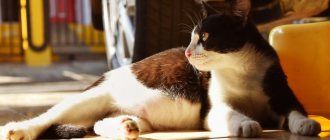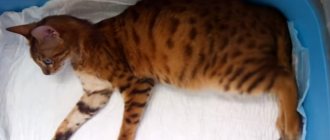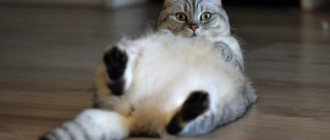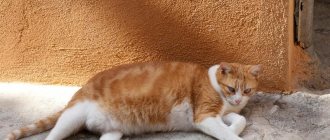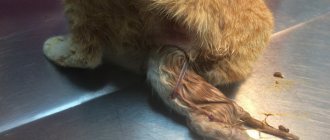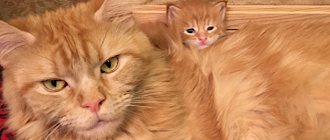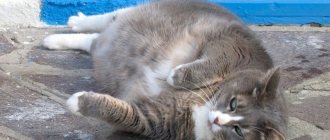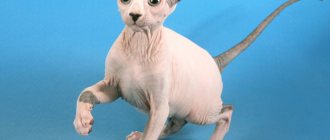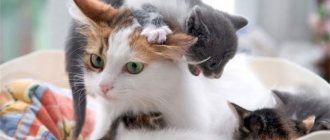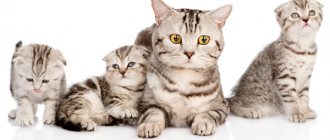The extraordinary appearance of sphinxes sometimes raises suspicions that even the simplest physiological processes in this breed are “not like everyone else.” As a result, a novice breeder has no idea how to care for a pregnant hairless cat in order to get healthy babies. Therefore, it is important to clarify in advance how long gestation lasts, how the cat’s birth proceeds, and how the owner should behave if the Sphynx is pregnant.
How to tell if a cat is pregnant
After the planned mating has taken place, the owner needs to make sure of its effectiveness. Not every contact with animals becomes productive, and even more so with purebred Sphynx cats. But if the desired event does happen, you can find out about it by certain signs. From the first week of pregnancy, characteristic changes occur in the appearance and behavior of the animal.
Pregnant Sphynx - behavior change
Sphinxes are incredibly affectionate and sociable, despite their extraordinary appearance and unfriendly “facial expression”. In the first phase of pregnancy they begin to require more attention. This period does not last long, and the cat’s mood changes dramatically: the pregnant woman becomes capricious and aggressive.
Eating habits are also changing. A pregnant Sphynx refuses her usual food and develops new gastronomic preferences. Manifestations of toxicosis are possible: in the 3rd week, the cat may feel sick in the morning. We can say that a pregnant Sphynx behaves like all women in an interesting position.
All these changes are caused by a sharp hormonal change in the body: the cat will have to bear offspring and provide them with the necessary nutrients.
This period will end in 2–3 weeks. The pet's behavior will stabilize, the appetite will return and even become stronger. A pregnant Sphynx should be fed more often than usual, but the portions should be smaller. The cat's behavior will become calm and she will sleep more.
Pregnant Sphynx - external changes
Signs of pregnancy become obvious 3 weeks after mating. They are not difficult to spot because sphinxes are hairless. The nipples become enlarged and take on a milky or pink hue. Weight gain is also a characteristic sign of pregnancy.
The physical changes in an ordinary cat are hidden under the fur, so their pregnancy often comes as a surprise to their owners.
Nursery services
There are several “closed cats” in the nursery, which are used exclusively for mating with local cats. In order to use the services of one of these representatives, a mating agreement is concluded and it is quite expensive. The peculiarity of using nurseries is a 100% guarantee of obtaining healthy and purebred offspring, but for this you need to undergo a check, pass all the necessary tests and give the cat a manicure. Only after that the cat is invited to her.
Saving on mating can turn into a real disaster, which is not recommended. So, after saving on dates, you can get motherless offspring in the form of sick kittens that will have to be treated.
Daily procedures will cost a lot and will not guarantee the animals’ complete recovery. Such experiments can harm the cat itself, because untested cats can have a number of diseases that will be passed on to their offspring. Age will not play a role here, as well as many other features and characteristics.
Where to find a mate for your pet:
- according to the white list in nurseries;
- according to numerous advertisements on the Internet;
- at exhibitions that are held several times a year;
- in special clubs for cats, where this is stated in the rules.
Mating will depend on the title and breeding value of the cat. All necessary documents must be with the owner, who can provide them upon request.
https://youtube.com/watch?v=Jkx0h6pdNpk
How long does pregnancy last in Sphynx cats?
The average length of pregnancy for Sphynx cats is 58–68 days. Childbirth at this stage is considered physiological, and kittens are born viable and healthy. Primiparous Sphynx cats usually stay pregnant longer than multiparous ones, and they have fewer kittens.
This is interesting! The gestation period for short-haired and hairless cats is shorter (58–68 days) than for long-haired cats (62–72 days).
Features of the behavior and appearance of the sphinx depending on the stage of pregnancy.
| Gestational age | What happens in a cat's body | Appearance | Behavior |
| 1 Week | Fertilized cells begin to divide. Attachment of the embryo to the walls of the uterus occurs after the 7th day. | There are no visible changes. | The cat becomes more affectionate. |
| 2–3 weeks (8–21st day) | The formation of the placenta begins and the process is completed by the 15th day of pregnancy. | Swelling, enlargement and change in color of the nipples. | The cat is capricious, picky about food, and tries to hide in a secluded place. |
| Week 4 (22–28 days) | The embryos begin to form internal organs. | Weight gain. Belly shaping. | The likelihood of toxicosis. The appetite is returning. |
| 5–6 weeks (29–42 days) | Formation of sensory organs, nervous system, muscle and bone frame of the fetus. By the end of the 6th week, the sex of the kittens can be determined by ultrasound. | The belly becomes noticeable. The nipples and mammary glands are clearly visible. The kittens are observed moving. An experienced veterinarian can determine their number by palpation. | The cat sleeps a lot. At this time, it is very important to provide her with psychological comfort and peace of mind. |
| 7–8 weeks (43–56 days) | The skeletal system of embryos is fully formed. The development of the fetal body is completed. Kittens are ready to be born. | The Sphinx's belly reaches its maximum size. | A good appetite and plenty of sleep are a guarantee of a successful delivery. |
| Week 9 (days 56–63) | Continuing pregnancy. Kittens “mature” in the mother’s body. | The mammary glands increase in size and begin to secrete colostrum when pressed. Whitish discharge appears from the vulva. | The Sphynx cat is showing signs of restlessness and is looking for a place to build a nest for its offspring. She pays a lot of attention to the intimate toilet. Frequent urination is noted. Appetite may decrease. |
Is it possible to influence the number of kittens?
This question is usually asked by cat breeders who sell kittens. After all, not only the expected profit directly depends on the number of offspring, but also covering the financial resources that were spent on mating with a good sire, tests, treatment, nurturing and feeding the future “money bag”.
Depending on the regalia of the male, the cost of mating can reach 10 thousand rubles. In most cases, owners of inseminators do not try to in any way influence the male health of their charges. Like we get money for mating, and then your problems: whether you got pregnant or not, how many kittens were born - it doesn’t concern us. This attitude is fundamentally wrong, and both sides should be interested in the offspring. Therefore, before you give money, ask:
- how often is a cat used for mating;
- is he eating well?
- does he have any diseases of the genitourinary system;
- how many kittens other cats bring from him;
- Does he suffer from cryptorchidism?
To increase fertility, many professionals advise injecting cats with:
- Ovariovit is a homeopathic drug, its action is aimed at restoring ovarian function, regulating the reproductive cycle and increasing fertility;
- Gamavit is an anti-stress, immunostimulating drug that supports the vitality of the body, and has a positive effect on eggs;
- Vitamin E – prevents infertility, has a positive effect on the reproductive system.
There is even a special scheme designed for 10 days:
- Ovarium (stimulates the protective function of the reproductive system) - half a cube is administered subcutaneously once a day;
- Ortilin (reduces the risk of inflammatory processes in the uterus) – one tablet twice;
- Ovariovit one tablet twice;
- vitamin E capsule twice a day;
- Gamavit one cube a day subcutaneously;
- Catozal (to normalize metabolism, increase immunity, resistance to stress) one cube per day subcutaneously.
Before putting any regimen into practice, consult your veterinarian!
Why does this work?
- Treatment may worsen estrus symptoms and increase hormone levels.
- At the same time, the cat becomes more attractive to the inseminator and is ready to attack the future father.
By the way, you can “stimulate” the cat by injecting him with B vitamins a couple of days before mating, which have a beneficial effect on the body’s endurance and activity.
Regarding the opposite effect (low fertility), there are no proven schemes as such. For example, there is an opinion that if after giving birth a cat with multiple births is left with only two kittens, then a certain switch is triggered in the body and the next time the animal will bring exactly two kittens. Although in practice, I personally have never observed such a phenomenon.
You can also do the opposite:
- poorly fed;
- keep under stress;
- exploit more often, forcing her to become pregnant every time she is in heat;
- periodically use hormones that inhibit the functioning of follicles.
In such living conditions, the body will quickly become exhausted and the cat will definitely stop giving birth a lot, if at all.
Pregnant Sphynx: features of caring for the expectant mother
A pregnant Sphynx cat should be surrounded with care and attention. It is necessary to provide adequate nutrition with a balance of vitamins and minerals. A sufficient amount of protein and calcium in the expectant mother's diet will ensure the proper development of the kittens. The best solution to the problem is to purchase special food for pregnant cats.
Ensuring the psychological and physical comfort of the pregnant woman is no less important. If the sphinx did not have her own bed, you should arrange a secluded corner for her where the birth will take place - for example, install a spacious box with low sides. A soft bedding is placed at the bottom, which is easy to change if necessary. Disposable diapers are suitable for this purpose.
From the second half of pregnancy, it is advisable to protect the sphinx from the need to make sudden movements, protect her from accidental blows and falls, and high jumps. To lift a cat, you need to grab it under the chest with one hand and under the hind legs with the other.
During pregnancy, it is strictly forbidden to carry out antiparasitic treatment - this will harm the offspring. Do not use any medications unless absolutely necessary and without consulting a veterinarian.
If the cat is kept free-range, this practice will have to be stopped during pregnancy to avoid trouble. The sphinx should be protected from contact with the opposite sex.
Important! Sometimes a cat may go into another heat cycle even when she is pregnant. This happens with a lack of progesterone. If mating occurs during estrus during pregnancy, secondary fertilization is possible. Both “batch” of kittens will be born at the same time, but those conceived later will be born non-viable.
Maintaining good hygiene is very important. Sphynx cats sweat more due to hormonal changes. In the first weeks of pregnancy, you can wash them as usual. Closer to childbirth, it is better to limit yourself to frequently wiping the body with a damp cloth. After the procedure, you need to wrap the cat in a warm towel to avoid hypothermia.
What does (low) multiple pregnancy depend on?
There are both a huge number of hypotheses and scientifically proven facts on this matter. Our topic is not a dissertation for an academic degree, so we will lump all theories and evidence into one common pile.
- Proper and nutritious nutrition has an important influence on conception, subsequent pregnancy and childbirth: the worse a cat eats, the less likely it is to become pregnant. There is such a thing as nutritional infertility - in this way nature tries to prevent the appearance of non-viable or sick offspring.
- The weight of the pet also plays an important role in the production of eggs and subsequent pregnancy. It is well known that obese females not only do not become pregnant, but they, in principle, do not go into estrus - what kind of multiple pregnancy can we even talk about in this case?
- Living conditions: comfort, warmth, cleanliness, lack of stress, etc.
- Hereditary factor: if a cat was born from a low-fertility mother, then the likelihood that she will also produce “a little” kittens is very high!
- A history of infectious diseases that somehow affect the development of reproductive function.
- Diseases of the reproductive system and injuries also affect the number of eggs produced.
- The temperament of a cat, no matter how strange it may sound. After all, it is well known that ovulation in cats occurs at the moment of coitus, and the sexier the male is, the more he cares for the bride, the more eggs will be released.
- Incompatibility with the opposite sex, which also occurs in humans. So, for example, there lived an allegedly infertile cat who was in heat, and they bred her with three different cats, but there was no effect. Until her permanent fiancé appeared in her living space. Apparently, the every minute presence of the cat, its smell, awakened hidden possibilities in the “woman’s” body.
- Let’s remember once again about cats, or more precisely about the quality of their sperm. The weaker the sperm, the smaller their number, the more underdeveloped among them, the less the chance of getting healthy, and most importantly, multiple offspring from a healthy cat. In turn, the quality of sperm depends on the nutrition of the reproductive system and the frequency of its use (both excessive use and abstinence have a negative impact on reproductive function).
- Low hormonal levels of the expectant mother, when the follicles produce few eggs ready for fertilization.
- Long-term use of antisex hormones will not only affect the number of offspring, but also its viability. Most often, a cat mated after such therapy brings 1-2 kittens, while they are weak or not at all capable of life outside the womb.
- Individual characteristics of the body, size, weight, age, etc., etc.
- Breed is another factor. For example, outbred cats can give birth to many kittens in the first, subsequent, and very last pregnancies. Whereas blue-blooded animals rarely bring more than 5.
- It is believed that the number of matings affects the number of kittens. Allegedly, after the first mating, the animal brings 1-2 kittens, by the seventh it reaches its natural maximum, and after that the number of offspring decreases again.
- Another theory, more like nonsense, says: the sooner insemination occurs from the start of estrus, the more kittens will be born.
What you may need during childbirth
Under natural conditions, all animals give birth on their own, but domestic cats need help. The characteristics of the breed can cause an unfavorable course of labor, so the presence of a specialist will not be superfluous.
Before giving birth, it is necessary to prepare the following “obstetric kit” in advance:
- sterile latex gloves;
- disinfectant;
- scissors with blunt ends for opening the amniotic sac;
- pipette with a round tip - to suck out liquid from the kitten's respiratory tract;
- small pieces of clean cloth that does not leave lint;
- artificial nutrition for newborns (if the young mother does not have milk).
Weighing scales, paper and pen for recording the weight and time of birth of kittens are an important addition. This will allow you to track the physical development of the offspring “from scratch.”
Stages
British cats are pregnant for just over two months. Bearing kittens is divided into several stages. For simplicity, we divide pregnancy into three stages:
- Beginning of pregnancy. The first stage lasts up to 25 days. The nipples noticeably turn pink, the belly increases slightly, becomes rounded and flexible. After 14 days, the fruits increase by about a centimeter. Limbs gradually form, internal organs begin to form. The cat eats abundantly, sleeps more often, and begins to look closely at the place where the future birth will take place.
- Mid-pregnancy. The second stage allows you to determine pregnancy with the naked eye at home. British cats are gentle and vulnerable animals; pregnancy takes a lot of strength and energy, so it would be a good idea to make an appointment with a specialist. Of course, in most cases the cat is able to give birth on her own, but a little safety net won’t hurt.
- At this stage, the brain, bone tissue (at first in the form of cartilage), muscle tissue, and the makings of the genitourinary system are actively formed. Claws are formed, the fetus vaguely resembles a kitten. The stage lasts on average 7-12 days. By the end of the trimester, kittens reach a size of 3 cm.
- End of pregnancy (preparation for childbirth). The “interesting” situation is entering its final phase. Due to the large belly (depending on the number of kittens), it is uncomfortable for the cat to walk and lick itself. Much at the third stage depends on the owner. From the attention and guessing of a silent and sometimes overly noisy British cat.
- The owner must make sure that the pet has enough food and clean fresh water, and a place for birth is equipped (even if it is a simple cardboard box). You can even turn it into a comfortable place to relax. In addition, at first, the kittens will live near the cat and begin to explore the outside world when they grow up a little. Without supervision, even a small apartment is fraught with many dangers for newborns.
By 40-45 days, kittens develop hair and an individual color. The third stage should be fully controlled either by a specialist or by family members. The cat may experience panic, depression, lethargy, and go to the toilet in the wrong place. If you touch the belly of a British cat, you can feel the movement of newborns.
How does childbirth occur in sphinxes?
The time of birth is easy to calculate taking into account the date of the planned mating. The cat should be monitored more closely during the last week of pregnancy. You should not leave the sphinx alone for a long time; she requires the presence of her owner. Her behavior changes: she either tries to hide, then calls her owner, often lies down in her nest and leaves it.
1-3 days before the end of pregnancy, the Sphynx's temperature may drop: the tips of the ears and paws become cold. All of these are behavioral symptoms of impending labor.
Signs of imminent labor
The following signs will notify you of the onset of labor:
- the cat actively licks the belly and vulva;
- breathing rate increases;
- the cat arches its back and meows - contractions begin;
- thick red-brown or transparent mucus is released from the vulva - the plug has come out, the uterus has begun to open.
When labor begins, you need to calm the cat down. If she rushes around the house, she needs to be taken into a box and laid on her side - this is the most comfortable position. You should not allow the Sphynx to sit down - an inexperienced mother can injure or crush the kitten. The owner's voice and stroking will calm the animal.
Pregnant Sphynx: stages of labor
Labor takes place in several stages:
- The passage of the mucus plug indicates the beginning of the first stage of labor.
- Period of contractions. Its duration can reach 12 hours. At this time, the uterine os opens (it is bicornuate in cats). During the birth process, kittens (alternately from different horns) will enter the body of the uterus to be born. When the interval between contractions is reduced to 30–40 seconds, the next stage begins.
- Pushing period. Muscle contractions push the fetus towards the birth canal, pressure on which causes pushing. The cat pushes, expels the fetus through the birth canal.
- Stage of childbirth. The kitten is born in the amniotic sac. The Sphinx actively licks it, thereby breaking the membrane, removing amniotic fluid from the throat and stimulating respiratory activity. In the next push, the placenta comes out, which the cat eats after chewing the umbilical cord. The mother then pushes the firstborn towards the nipple. Active sucking stimulates subsequent labor.
After a short break, the entire cycle is repeated as many times as kittens were conceived. On average, the labor of a sphinx lasts from 2 to 8 hours. After several kittens are born, labor may stop. This is not a cause for alarm: labor will resume in a few hours.
Inexperienced obstetricians may be shocked that a cat eats the placenta. This process cannot be interfered with. The placenta contains hormones and biologically active substances that help during childbirth: they give strength and stimulate uterine contractions.
Felinologists advise allowing the cat to eat the first 3-4 afterbirths, and removing the rest as they appear.
Choosing a mating partner
Shortly before breeding Canadian Sphynxes, you should definitely take the animals to the veterinarian to make sure that your cat does not have any diseases. In addition, approximately fifteen to twenty days before mating, both partners should undergo deworming for the purpose of prevention. This will allow your pet to receive a guarantee that pregnancy will not be complicated by the presence of worms.
Check your cat's readiness to bear offspring with a veterinarian
Immediately before mating, both the male and the female must trim their claws, otherwise the animals may injure their partner during the mating process. And keep in mind that you should never wash cats before breeding. This is explained by the fact that washing can destroy the real smell of the cat, which attracts the male, which, in the end, can result in a failed mating.
In what situations do you need help?
If the owner of a purebred cat is not sure that he can cope with the birth process on his own, you need to invite a veterinarian.
In force majeure circumstances, the woman in labor will have to help herself. This happens during a rapid birth: the kittens come one after another, and the mother does not have time to cope with them. An example situation: the cat has not finished licking the first one, the second kitten has already appeared, and attempts are being made on the third.
Assistant actions:
- quickly and carefully free the newborn from the membrane of the amniotic sac, slightly cutting it;
- using a sterile napkin, release the kitten from the shell;
- wipe him, at this moment he should begin to breathe;
- if the kitten is not breathing, you should turn it head down and shake it slightly;
- if this also does not help, you need to suck out the liquid from the spout using a pipette and do a light massage of the chest - rhythmically press on the heart area;
- Place the kitten close to the mother's nipple and help her latch on to it.
The cat did not have time to gnaw the umbilical cord:
- Tie the cord tightly with a clean thread at a distance of 1–2 cm from the kitten’s belly;
- cut the umbilical cord with scissors from the placenta side;
- remove the placenta.
The fetus came out partially, got stuck in the birth canal - the sphinx does not have enough strength to push. In this situation, you need to act as follows:
- lubricate the vulva around the fetus with Vaseline oil;
- Carefully grab the kitten using a napkin;
- wait for the next push, then lightly pull and help him come out;
- place the newborn next to the mother.
Normally, childbirth in sphinxes lasts from 4–5 hours to a day. The completion of labor is indicated by the behavior of the cat. She begins her own hygiene after licking the kittens.
To maintain your cat's strength, you can give her warmed milk with yolk.
Preparing for the event
Sphynx pregnancy lasts about two months - from 60 to 70 days. During this time, you should get used to the idea of expanding your family and prepare for the event. There is no need to worry about the process itself. As a rule, females cope with everything themselves. Sphynx cats have very well developed maternal instincts, so if the cat is healthy and has not had any problems during pregnancy, trust her. But there are points that you should take care of.
Location requirements
Cats are independent creatures and love to spend time alone and in silence. And during the birth process, cats generally have a special mental state, so they need peace and privacy. It would be better if it was a separate, quiet room. But you can select a secluded corner and put a special cat house in it or build it from a large cardboard box.
We recommend reading: How does a puppy behave in the heat?
The best option is if it opens from the top, but has a small hole on the side so that the cat can get out to eat and go to the toilet. This hole should be located at such a height that small kittens cannot then accidentally crawl out of the box. You need to lay something soft inside to make it warm and comfortable. But cover it with disposable diapers (can be purchased at any pharmacy or children's store). These diapers are very soft, absorb moisture well and are easy to change.
As soon as you notice that the pet has begun to worry, look for a secluded place and drag soft things there, place it in the house and stay with it, gently talking and stroking it. This way the animal will calm down and understand that there is no need to look for a place anymore.
Materials and tools
Usually cats cope with everything themselves: they help the kitten to appear, lick it, and gnaw the umbilical cord. But you must be ready to join the process at any time and help your pet. Especially if she is giving birth for the first time.
So, you will need:
- sterile medical gloves, which can be purchased at any pharmacy;
- sterile thread, disinfectant, scissors. You will need these tools if you need to cut the umbilical cord;
- small pipette or syringe: for sucking liquid from the nasal and oral cavity;
- clean soft napkins or pieces of cloth;
- Vaseline oil;
- artificial food: it is better to purchase a special one for cats, but as a last resort, for the first time you can get by with high-quality children’s food;
- if you want to monitor whether the baby is developing correctly, then scales, paper and a pen to record the weight;
- colorful ribbons: used to mark kittens. It is very convenient when artificial feeding or when there are a lot of babies, they help make sure that everyone eats.
Aftercare for the animal
Mucous and bloody discharge from a cat’s genitals after birth is normal. If they do not stop after a week, you need to show the animal to a veterinarian. After labor is completed, you need to change the litter, then do this daily.
The owner must provide the new mother with care and concern. During the first day, the cat does not leave the nest, as it protects its offspring. You can place a toilet and bowls of food and water near the house so that the mother can recuperate. It is very important not to disturb the new family at this time.
Sphynxes do not like cool weather. You can put a warm heating pad in the nest and cover the box with a blanket so that the kittens do not get entangled in it.
Particular attention is paid to nutritious nutrition. Preference should be given to wet food for pregnant and lactating cats. The Sphynx also needs to drink a lot - fresh water should be available constantly.
The hardest part is over, but the worries don't end. To help a cat raise healthy offspring, there is still a lot of work to be done. Let them be pleasant!
Description of the breed
Many people spoke quite impartially about this breed, pointing out that sphinxes have no future, since they are unaesthetic animals and sensitive to cold. They argued that the breed was of purely technical interest.
At the same time, many generally considered animals to be harmful and abnormal, since they are not able to provide for themselves on their own and are completely dependent on humans.
If we talk about modern sphinxes, then their description will not be unambiguous, since even one breed may differ in some differences in the exterior, as well as in the type of hairlessness.
Appearance
Modern Sphynxes practically no longer have the main feature - folded skin, which created the appearance of cats similar to wrinkled old men. These days, these are animals that resemble smooth porcelain figurines. It should be noted that kittens do have some excess skin, but this disappears over time as they grow older, although these obvious signs can still be seen on the neck or head.
Nowadays, among the Canadian sphinxes one can still note a significant number of the most folded specimens.
According to many experts, a large proportion of modern Sphynxes are beginning to degenerate and are becoming more and more similar to the hairless Devon Rex of the usual type, with thin skin, relatively round eyes, low-set mustaches, a short head and a bone structure that is uncharacteristic of Sphynxes.
Sphynx – All about the breed
Watch this video on YouTube
Breed standards
Each breed of hairless cats has its own beauty criteria. In addition, it should be noted that within each breed several variants of the requirements for the exterior of cats can coexist. Sphynx cats, for example, are valued according to both CFA and TICA standards.
The most interesting thing is that experts are of little interest in the fact that an animal has no hair, since they pay more attention to the shape of the head, the constitution of the body, the grace of movements and the general impression created by the breed. As for the details, experts are interested in muscular limbs, with the hind legs longer than the front ones, the paws proportional, the tummy pear-shaped and, at the same time, an elegant tail, although it looks like a “rat”
As for the details, experts are interested in muscular limbs, with the hind legs being longer than the front ones, the paws being proportional, the tummy pear-shaped and, at the same time, an elegant tail, although it looks like a “rat’s”.
Skin folds are more characteristic of the head, muzzle, neck, and shoulders. If you touch the skin covered with delicate down, you feel warm suede
Any body color is taken into account, including those with white spots
A high-breed sphinx, as a rule, has a magical effect on those around it, which is due to the presence of rather smooth lines of the animal’s naked body, as well as the penetrating gaze of its unique eyes.
Character and behavior
As a rule, many are frightened by the unusual appearance of sphinxes, but those who dare to pick up this animal immediately turn into one of the lovers of these unique animals. Sphinxes are not known for their obsessive behavior, although they always prefer to be close to their owner. These animals have a peaceful and friendly character. They accept strangers as their long-time friends and easily get along with other animals in a person’s home.
In addition, sphinxes are considered intelligent, affectionate and affectionate creatures who can patiently wait for their owner if he is delayed for some reason.
These animals completely trust a person and love them if a person treats them the same way. These cats are easy to train due to their intelligence and memory. Moreover, these are strong animals that can reach a height of at least 1 meter without much effort.
Their behavior sometimes resembles that of a dog, since sphinxes are able to bring various objects to their owner. They easily open doors, as well as various cabinets, and can repeat basic tricks. Thanks to their unique appearance, as well as their natural acting talent, sphinxes are loved by filmmakers and photographers.
How long do sphinxes live?
At one time, a sphinx named Bambi set a longevity record, living for 19 years. Since then, no representatives of hairless cats have managed to break this record.
According to experts, the average life expectancy of sphinxes is just over 12 years, which is due to the consequences of breeding
In order for your pet to live as long as possible, special attention should be paid to a healthy diet, attentive care, and frequent visits to an experienced veterinarian.
Feeding frequency and feed rate
Undoubtedly, the lactation period is much more energy-intensive than any other. The amount of food consumed increases up to seven times. There is no unique formula to help calculate the time intervals between meals and the weight of portions. It depends on the weight of the nursing mother, the number of kittens, their age and weight. Of course, until the moment of separation, growing kittens will need more and more food for full development.
It is better not to limit the amount of food - animals instinctively know how much they need. On average, the volume of the menu increases 4-5 times. In the case of professional food, the instructions on the packaging will help; manufacturers indicate the weight of portions and the frequency of feedings. These data must also be adjusted for each animal.
It is better to give natural food in small portions, but more often, as it spoils faster. Exactly how much a cat needs can only be determined experimentally.
False and frozen pregnancy: diagnosis and treatment
| Types of pathologies | Causes of the pathological condition | Diagnostic methods | Treatment options |
| False (imaginary) pregnancy |
|
| Low-calorie diet, therapy aimed at normalizing the production of sex hormones or sterilization. |
| Frozen pregnancy |
| If not all embryos die, the pregnancy continues. Dead fetuses are released during the birth process along with the living ones. If not a single embryo survives, a miscarriage is expected or labor is induced with medication. After birth, the cat is examined to assess the cleanliness of the uterus. Often an animal that has suffered a frozen pregnancy is sterilized. |
Nutrition after the birth of babies
Refusal to eat in the first 5-6 hours after lambing is considered normal. It is necessary to control that the animal continues to drink, otherwise the cat will weaken before our eyes from dehydration. It is necessary to offer warm milk, low-fat meat broth, kefir diluted with warm water. You can add a little salt and sugar to the water to restore the body's natural needs.
Regidron solution is a good remedy recommended by experts for dehydration. Therefore, even during pregnancy, it is necessary to purchase it at the pharmacy.
Refusal to drink water is an alarming sign. Body temperature must be measured. A high indicator against the background of dehydration may indicate eclampsia. The condition is dangerously fatal, so you should immediately consult a veterinarian.
